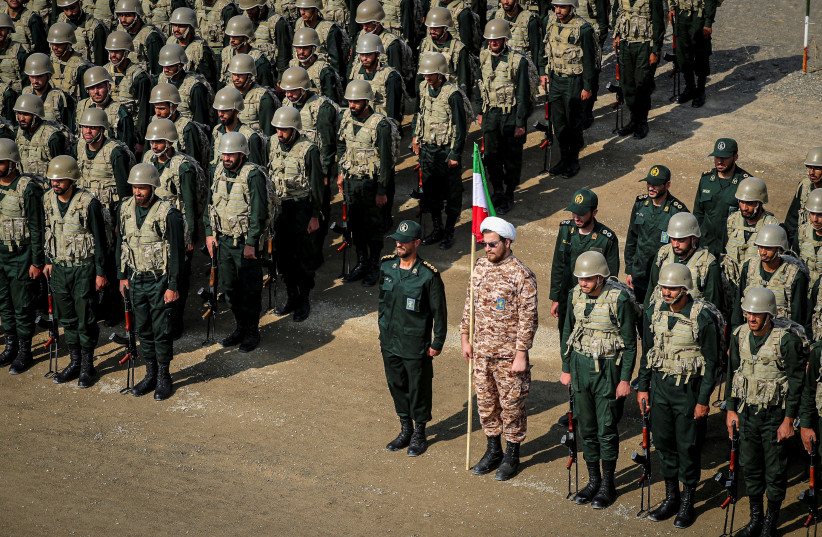Just after 6:30 in the morning, sirens sounded throughout central Israel. The sirens sent large numbers of Israelis to shelters and led to questions about whether schools would operate as usual on Sunday, September 15.
Sunday’s missile attack now joins a large number of unprecedented attacks on Israel since October 7. The recent attacks, such as the Hezbollah escalation on August 25, the Houthi drone attack on Tel Aviv on July 19, and the April attack by Iran, all illustrate that Iran and its proxies are not deterred.
Iran and its proxies are seeking to ring Israel with attacks on numerous fronts from various directions. This is why the Houthis launched a drone at Israel that flew in from the Mediterranean in July.
The drone exploded a block away from the US Embassy branch office in Tel Aviv, the former site of the US embassy, which was moved to Jerusalem in 2018. This was a major attack. It killed one person, and it symbolically showed that the Houthis and Iran’s axis could reach Tel Aviv with drones.
Entering an unprecedented chapter in Israeli history
Tel Aviv had already been targeted by Hamas rockets since October 7. However, the expansion in Iranian-backed attacks in the past year is unprecedented. It is not just unprecedented in terms of Iran and its proxies; it is unprecedented in Israel’s history. Israel has been threatened from multiple fronts in the past, such as in 1967.
Tel Aviv has also been threatened in the past, for instance, the Egyptians bombed Tel Aviv in 1948. However, when one adds up all the attacks on Israel over the past 11 months, the Iranian adversary has broken through a number of historic norms and spread the threats to a new level.
The attack on September 15 now joins this list. The real story here is that Iran and its proxies are undeterred. Israel has largely been on the defensive since October 7. After Israel was surprised by the massive Hamas attack, it had to mobilize troops and respond.
Today, Hamas has lost thousands of fighters in Gaza, and the IDF controls the Philadelphi corridor and a corridor across central Gaza. However, Hamas controls most of Gaza. Hamas attempted to target Ashkelon on September 14 by firing a rocket from northern Gaza. This shows that Hamas still has rockets and is still active in northern Gaza despite 11 months of fighting.
With Hamas still active in Gaza, there are also escalations by Palestinian Islamic Jihad, Hamas, and other groups in the West Bank. These groups have rapidly expanded their threats in the last two years.
They have stockpiled arms smuggled to the West Bank, and are well-armed with M-4 and AR-type rifles. The groups are also using more explosives and are even beginning to build tunnels. They have expanded their operations to areas such as Tubas, from Jenin. This has caused the IDF to launch an unprecedentedly large operation against terror in the West Bank in August. The IDF now uses drones to carry out strikes in the West Bank, yet another new norm. None of this would have been normal two years ago.
Along with Iran’s role in the West Bank and Gaza, Hezbollah has also expanded its attacks on Israel in August. The group killed 12 teens and children in Majdal Shams in July. When Israel retaliated, Hezbollah claimed it would also retaliate. It chose August 25 to carry out a large attack, which Israel preempted part of.
However, Hezbollah has continued to increase its attacks in September, often launching around 100 rockets a day. This has kept 60,000 Israelis evacuated from their homes in the North and left cities like Kiryat Shmona completely abandoned. This is unprecedented as well; never in Israel’s history has the country evacuated cities and dozens of small communities for 11 months. Hezbollah appears dauntlessly empowered.
Meanwhile, the Houthis and Iraqi-based militias are undeterred. Iran is also active in Syria. After the Houthis attacked Israel in July using a drone, the IDF retaliated with an attack on Hodeidah. These kinds of attacks ostensibly send a message of Israel’s capabilities.
However, the Iranian Axis is resolute. Iran sees Israel’s capabilities and is aware of them.
Pro-Iran media makes this clear. Iran’s Al-Mayadeen said on September 15 that the August attack by Hezbollah was successful. This could be read as saving face, but it also shows Hezbollah is prepared to deliver more attacks. Iran’s IRNA media boasted on the same day about Iran’s ties with Russia, a new satellite Iran has sent into orbit, and fresh Hezbollah attacks.
The overall message from Iran and its proxies is that it is undeterred and that it continues to wage a multifront war against Israel.
Israel is reacting while Iran is keying in its proxies to decide when and where to attack. Iran wants it this way. It wants to push its pawns closer to Israel’s center, and throughout 2024, it has repeatedly accomplished this strategy.

